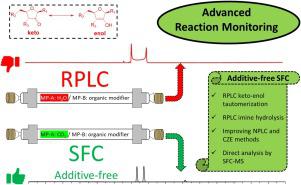The Journal of Supercritical Fluids ( IF 3.9 ) Pub Date : 2020-10-06 , DOI: 10.1016/j.supflu.2020.105068 Michael B. Hicks , Weidong Tong , Jason Kowalski , Akasha K. Purohit , Jimmy DaSilva , Erik L. Regalado

|
Reaction monitoring is crucial in order to guide pharmaceutical chemical processes towards successful outcomes. Many drug substances require the application of water/additive-free solvents to guide process efforts which are intrinsically incompatible with reversed phase liquid chromatography (RPLC) conditions. Sub/supercritical fluid chromatography (SFC) helps to overcome many of these challenges delivering unmatched speed, with low cost, high-efficiency and an additive-free environment ideal for reaction monitoring of species chemically susceptible to water. Herein, we provide several examples where traditional RPLC fails or delivers sub-optimal performance in monitoring processes. These examples include using additive-free SFC-UV and SFC-MS methodologies to overcome difficulties associated with: 1) on-column RPLC hydrolysis, 2) improving normal phase liquid chromatography, replacing capillary zone electrophoresis methods, and 3) avoiding the use of tedious pre-column derivatization procedures.
中文翻译:

通过亚/超临界流体色谱实现对制药过程的高级反应监控
为了指导药物化学过程取得成功,反应监测至关重要。许多药物需要使用水/不含添加剂的溶剂来指导与反相液相色谱(RPLC)条件本质上不兼容的工艺工作。次临界/超临界流体色谱(SFC)有助于克服许多挑战,提供无与伦比的速度,低成本,高效和无添加剂的环境,非常适合对易受水化学影响的物种进行反应监测。本文中,我们提供了一些示例,这些示例在监视过程中传统的RPLC失败或提供了次优的性能。这些示例包括使用无添加剂的SFC-UV和SFC-MS方法来克服与以下相关的困难:1)柱上RPLC水解,



























 京公网安备 11010802027423号
京公网安备 11010802027423号